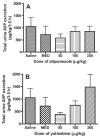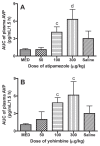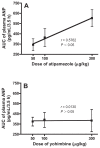Antagonistic effects of atipamezole and yohimbine on medetomidine-induced diuresis in healthy dogs
- PMID: 20046627
- PMCID: PMC2757706
Antagonistic effects of atipamezole and yohimbine on medetomidine-induced diuresis in healthy dogs
Abstract
This study aimed to investigate and compare the antagonistic effects of atipamezole and yohimbine on medetomidine-induced diuresis in healthy dogs. Five dogs were used repeatedly in each of 8 groups. One group was not medicated. Dogs in the other groups received 20 microg/kg of medetomidine intramuscularly and, 0.5 h later, saline (as the control injection), 50, 100, or 300 microg/kg of atipamezole, or 50, 100, or 300 microg/kg of yohimbine intramuscularly. Urine and blood samples were taken 11 times over 24 h for measurement of the following: urine volume, specific gravity, and creatinine concentration; urine and plasma osmolality; urine and plasma concentrations of electrolytes and arginine vasopressin (AVP); and the plasma concentration of atrial natriuretic peptide (ANP). Both atipamezole and yohimbine antagonized the diuretic effect of medetomidine, inhibiting medetomidine-induced decreases in urine specific gravity, osmolality, and concentrations of creatinine, sodium, potassium, chloride, and AVP and reversing both the medetomidine-induced increase in plasma concentrations of sodium, potassium, and chloride and the medetomidine-induced decrease in the plasma AVP concentration. Atipamezole significantly stimulated ANP release. The antidiuretic action of yohimbine was more potent than that of atipamezole but was not dose-dependent, in contrast to the action of atipamezole. The effects of these drugs may not be due only to actions mediated by alpha(2)-adrenoceptors.
L’objectif de la présente étude était d’examiner et de comparer les effets antagonistes de l’atipamezole et de la yohimbine sur la diurèse induite par la medetomidine chez des chiens en santé. Cinq chiens ont été utilisés de manière répétée dans chacun de 8 groupes. Un groupe n’était pas médicamenté. Les chiens dans les autres groupes ont reçu 20 μg/kg de médétomidine par voie intramusculaire et, 0,5 h plus tard, de la saline (injection témoin), 50, 100 ou 300 μg/kg d’atipamézole, ou 50, 100 ou 300 μg/kg de yohimbine par voie intramusculaire. De l’urine et des échantillons de sang ont été prélevés 11 fois sur une période de 24 h et les paramètres suivants ont été mesurés : le volume, la densité et la concentration de créatinine urinaire; l’osmolarité urinaire et plasmatique; les concentrations urinaire et plasmatique en électrolytes et d’arginine vasopressine (AVP); et la concentration plasmatique du peptide natriurétique atrial (ANP). L’atipamezole et la yohimbine avaient un effet antagoniste sur l’effet diurétique de la medetomidine en inhibant la diminution induite par la medetomidine de la densité urinaire, de l’osmolarité et des concentrations de créatinine, sodium, potassium, chlorure et AVP et en renversant l’augmentation des concentrations plasmatiques de sodium, potassium et chlorure et la diminution de la concentration plasmatique d’AVP causées par la medetomidine. L’atipamezole a stimulé de manière significative la relâche d’ANP. L’effet antidiurétique de la yohimbine était plus marqué que celui de l’atipamezole mais n’était pas dose dépendant contrairement à l’action de l’atipamezole. Les effets de ces médicaments ne sont peut-être pas uniquement associés à des mécanismes à médiation par des adrénorécepteurs α2.
(Traduit par Docteur Serge Messier)
Figures






Similar articles
-
Antagonistic effects of atipamezole, yohimbine, and prazosin on xylazine-induced diuresis in clinically normal cats.Can J Vet Res. 2014 Oct;78(4):304-15. Can J Vet Res. 2014. PMID: 25356000 Free PMC article.
-
Antagonistic effects of atipamezole, yohimbine and prazosin on medetomidine-induced diuresis in healthy cats.J Vet Med Sci. 2014 Mar 1;76(2):173-82. doi: 10.1292/jvms.13-0398. Epub 2013 Oct 8. J Vet Med Sci. 2014. PMID: 24107430 Free PMC article.
-
Antagonistic effects of atipamezole and yohimbine on xylazine-induced diuresis in healthy dogs.J Vet Med Sci. 2009 May;71(5):539-48. doi: 10.1292/jvms.71.539. J Vet Med Sci. 2009. PMID: 19498277
-
Diuretic effects of medetomidine compared with xylazine in healthy dogs.Can J Vet Res. 2009 Jul;73(3):224-36. Can J Vet Res. 2009. PMID: 19794896 Free PMC article.
-
Medetomidine sedation in dogs and cats: a review of its pharmacology, antagonism and dose.Br Vet J. 1996 Sep;152(5):519-35. doi: 10.1016/s0007-1935(96)80005-4. Br Vet J. 1996. PMID: 8885463 Review.
Cited by
-
Antagonistic effects of atipamezole, yohimbine, and prazosin on xylazine-induced diuresis in clinically normal cats.Can J Vet Res. 2014 Oct;78(4):304-15. Can J Vet Res. 2014. PMID: 25356000 Free PMC article.
-
Antagonistic effects of atipamezole, yohimbine and prazosin on medetomidine-induced diuresis in healthy cats.J Vet Med Sci. 2014 Mar 1;76(2):173-82. doi: 10.1292/jvms.13-0398. Epub 2013 Oct 8. J Vet Med Sci. 2014. PMID: 24107430 Free PMC article.
-
Comparison of Atipamezole with Yohimbine for Antagonism of Xylazine in Mice Anesthetized with Ketamine and Xylazine.J Am Assoc Lab Anim Sci. 2017 Mar 1;56(2):142-147. J Am Assoc Lab Anim Sci. 2017. PMID: 28315642 Free PMC article. Clinical Trial.
References
-
- Khan ZP, Ferguson CN, Jones RM. Alpha-2 and imidazoline receptor agonists. Their pharmacology and therapeutic role. Anesthesia. 1999;54:146–165. - PubMed
-
- Schwartz DD, Clark TP. Selectivity of atipamezole, yohimbine and tolazoline for α2-adrenergic receptor subtypes: Implications for clinical reversal of α2-adrenergic receptor mediated sedation in sheep. J Vet Pharmacol Exp Ther. 1998;21:342–347. - PubMed
-
- Ernsberger P, Meeley MP, Mann JJ, Reis DJ. Clonidine binds to imidazoline binding sites as well as α2-adrenoceptors in the rostral ventrolateral medulla. Eur J Pharmacol. 1987;134:1–13. - PubMed
-
- Scheinin H, Virtanen R, MacDonald E, Lammintausta R, Scheinin M. Medetomidine — a novel α2-adrenoceptor agonist: A review of its pharmacodynamic effects. Prog Neuropsychopharmacol Biol Psychiatry. 1989;13:635–651. - PubMed
-
- Virtanen R. Pharmacological profiles of medetomidine and its antagonist, atipamezole. Acta Vet Scand Suppl. 1989;85:29–37. - PubMed
Publication types
MeSH terms
Substances
LinkOut - more resources
Full Text Sources
Miscellaneous
